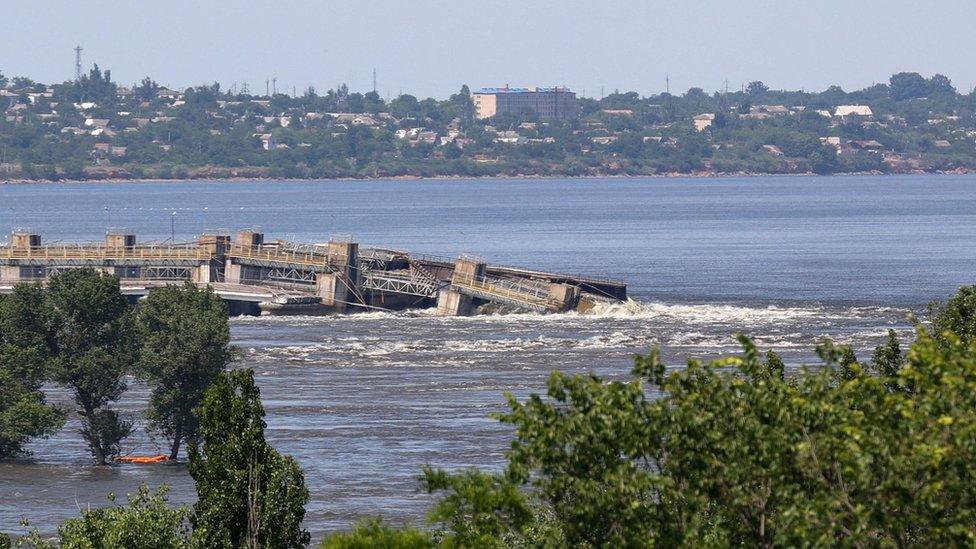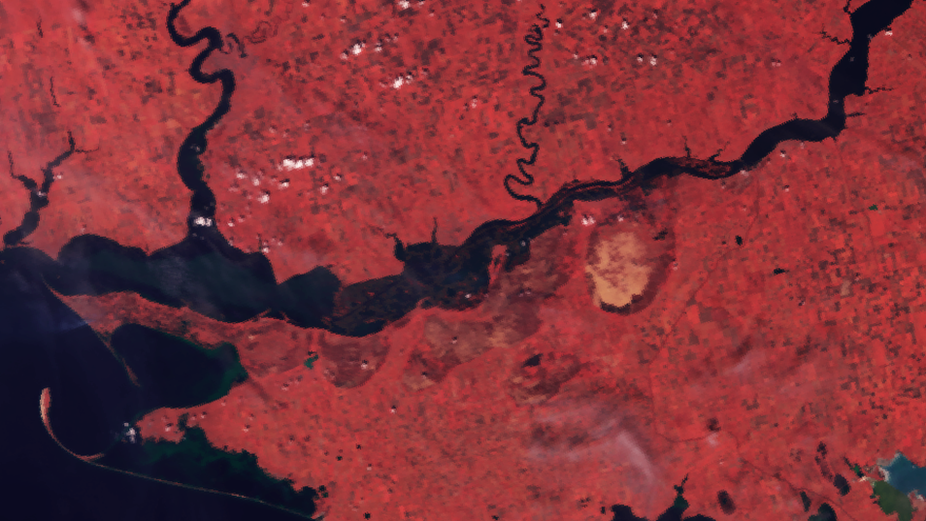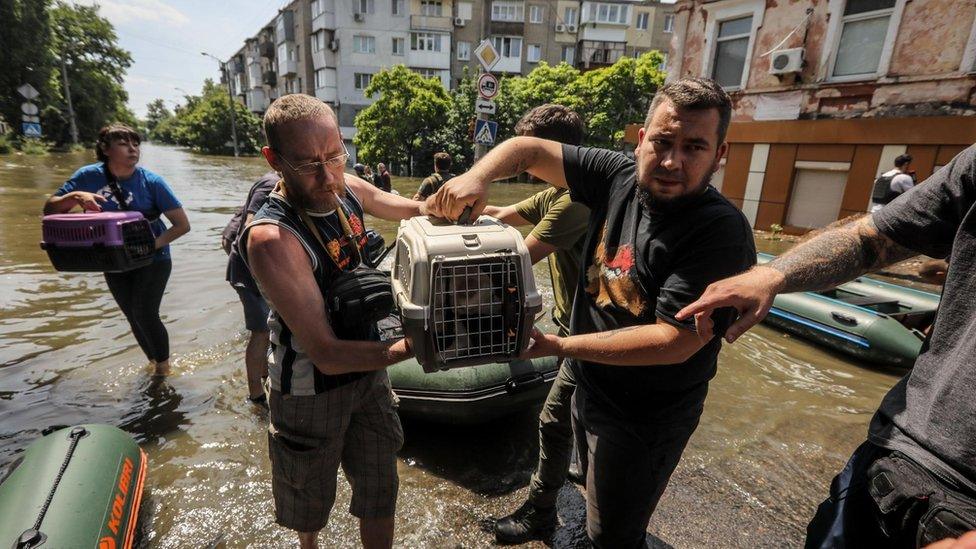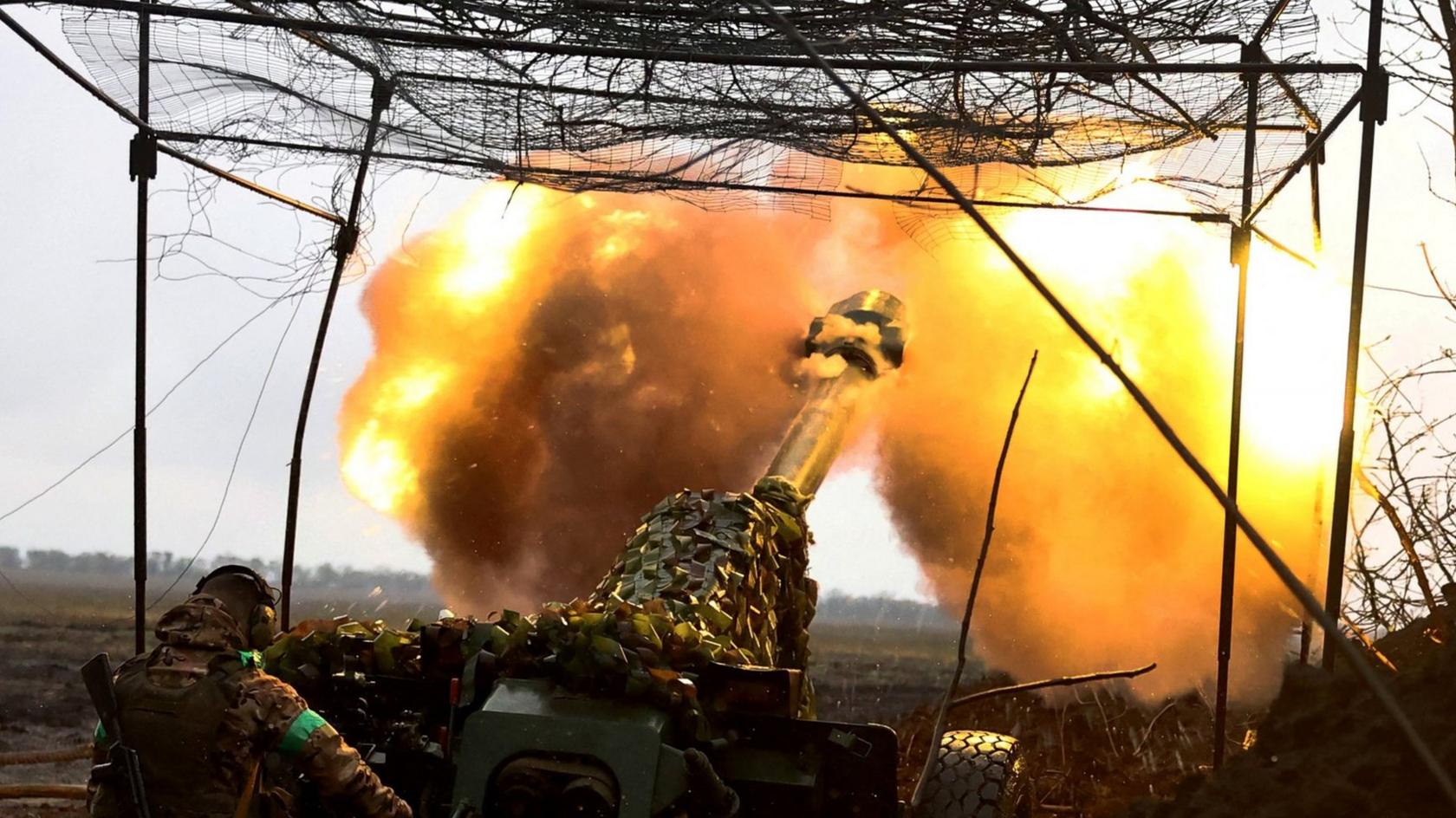Ukraine dam: What we know about Nova Kakhovka incident
- Published

A huge dam in the Russian-controlled area of southern Ukraine has been destroyed, unleashing a flood.
Ukraine's military and Nato have accused Russia of blowing up the dam, while Russia has blamed Ukraine.
Thousands of people have been evacuated from low-lying areas either side of the river Dnipro.
UN humanitarian aid chief Martin Griffiths has warned of grave and far-reaching consequences. Here's what we know so far.
Where is the dam?
The Kakhovka Hydroelectric Power Plant is in the city of Nova Kakhovka in the Kherson region. The city is currently under Russian occupation.
The dam was built in the Soviet era and is one of six that sit along the Dnipro river, which stretches from the very north of the country into the Black Sea. In Kherson region, Russia occupies the left, or southern, bank while Ukraine controls the right, or northern, bank.
The dam holds back a huge reservoir, which locals call the Kakhovka Sea as you cannot see the other bank in certain places.
What happened?
Video footage showed a massive breach in the dam, with water surging through it and flooding downstream in the direction of Kherson.
Ukrainian dam operator UkrHydroEnerho said the Nova Kakhovka station was "fully destroyed" and could not be restored.
It's unclear when exactly the dam was first damaged, but satellite images suggest its condition deteriorated over a number of days.
As water from the vast Kakhovka reservoir poured through the damaged dam, agricultural land and dozens of villages and towns were quickly flooded.
Thousands of people from both sides of the river have been evacuated from their homes, but the full scale of the disaster is not yet clear.

There are also major environmental concerns. The river has been contaminated with 150 tonnes of industrial lubricant, said President Volodymyr Zelensky, and another 300 tonnes was at risk of leaking.
Agricultural land has been washed away and the consequences of the flooding on local farmland is likely to be felt for years.
Landmines are also being dislodged by the floodwaters, prompting concerns not just for residents in Kherson, but also those coming to provide assistance.
Erik Tollefsen, head of the Red Cross's weapon contamination unit said they had lost track of where the landmines were: "All we know is that they are somewhere downstream."
President Zelensky visited the flood-hit region on Thursday and said the priority was to "protect lives and help people as much as possible".
He also visited a crossing point in the city where people were being evacuated from the flooded area and a medical facility.
Has the dam been attacked?
It's not yet clear what caused the breach in the dam, but Ukraine's military has accused Russia of deliberately blowing it up.
Moscow may have feared that Ukrainian forces would use the road over the dam to get troops across the river into Russian-held territory, as part of a counter-offensive.
Mykola Kalinin, chief engineer at a hydropower and water management engineering company in Ukraine, Ukrhydroproject, claimed that an explosion was the cause.
The dam, he told Ukrainian data journalism site Texty, was "built to withstand a super-powerful impact from the outside". Mr Kalinin concludes that it was mined from the inside.
But Kremlin spokesperson Dmitry Peskov blamed Ukraine, calling it an act of "sabotage" that would deprive the Crimean peninsula - an area annexed by Russia in 2014 - of water.
Neither Ukraine nor Russia's claims have been verified by the BBC.
Alternative theories of what could have caused, or at least contributed, to the breaching of the dam have been put forward.
Fighting in the area could have affected the structure, Mark Mulligan, professor of Physical Geography at University College London, told the BBC.
"Structural failure resulting from the impact of earlier damage associated with the war remains a possibility," Prof Mulligan said.
A second theory he put forward was that Russia, which controls the dam, deliberately allowed water levels to rise in the reservoir behind it - making a collapse more likely and more impactful.
According to analysis of satellite imagery carried out by the US Foreign Agricultural Service, external, water levels rose sharply over the last few months.

"The very high level of water in the reservoir coupled with previous damage, leading to uncontrolled flows of water through the dam could lead to catastrophic structural failure," Prof Mulligan said.
However, the dam's destruction is hard to assess on satellite imagery alone, as much of the damage is underwater.
"At this stage nobody knows except those on the ground, all else is speculation," Prof Mulligan added.
Mr Zelensky has accused the international community of not reacting fast enough to the flooding, and said without drinking water, food or medicine it was impossible to know how many people would die.
He has accused international organisations, like the Red Cross, of losing the ability to save lives. The World Bank has offered to conduct a rapid assessment of the damage and Ukraine's most urgent needs.
What was the purpose of the dam?
It held back a vast reservoir that supplied water to communities upstream, and provided cooling water to the nuclear power station at Zaporizhzhia, around 160km (100 miles) away, which is under Russian control.
The International Atomic Energy Agency (IAEA) said there was no immediate nuclear safety risk but it was monitoring the situation.
It later said that if the dam did fall below 12.7m, the lowest level at which water can still be pumped upstream to Zaporizhzhia, there were alternative water sources to keep the nuclear plant cool.

The dam was also a vital channel carrying water from the river to Russian-occupied Crimea, meaning water supplies there are likely to be affected.
After Russia annexed Crimea in 2014, Ukraine blocked a channel carrying water from Nova Kakhovka, triggering a water crisis on the peninsula.
Russian forces reopened the channel after last year's invasion. But without the dam, dropping water levels could once again jeopardise the flow of water along the channel.
Russia has previously carried out several attacks on dams throughout Ukraine since the invasion, causing widespread flooding and disrupting power supplies.
Related topics
- Published8 June 2023

- Published6 June 2023

- Published6 June 2023
